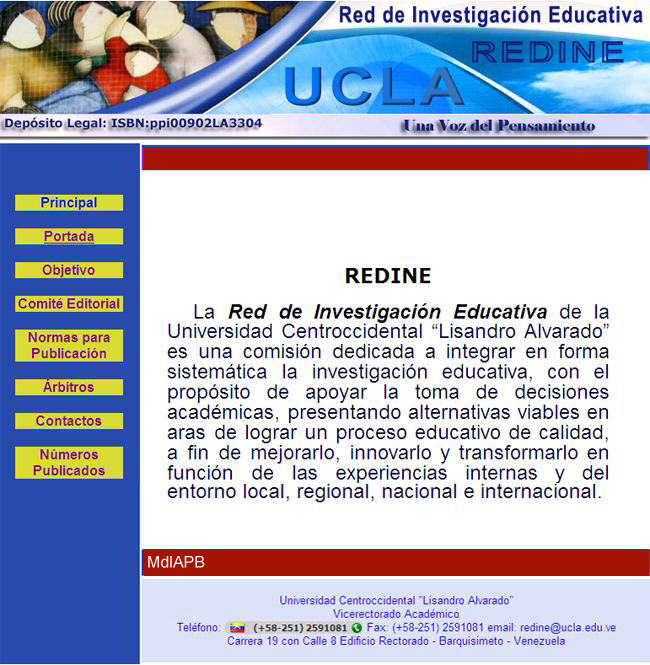estimation of designs of measurement for the analysis of the violence in televising reporters
Keywords:
violence, the news, variability, designs of measurementAbstract
In this work designs of measurement by means of a variability analysis were considered (Analysis of Components of Variance and Analysis of Generalizabilidad) to study the treatment that to him the Venezuelan televising channels grant, to the news on violence. This analysis allowed to consider the reliability, generalizabilidad, and variance associated to each one of the variables of classification in the raised designs of measurement, from two to five facets. For it two observacionales tools were elaborated: a system of field formats and a system of emergent categories. The results indicate that the considered designs are trustworthy and generalizables to populations with characteristics similar to those of the studied sample, in addition adjust to General the Linear Model. Significant differences between the variables Y (intensity of the news suggested by the televising channel), and Z have been obtained (intensity of the news perceived by the observer). In the variable and (suggested intensity) the models with smaller residual variance, and the greater frequency of meaning were obtained. Of these differences found in the variables, it is possible to be deduced that in the variable "Y ", the television channels could be stimulating the violence, by means of the treatment that they give to the news.
Downloads
References
Apter, M. J. (1982). The experience of motivation: The theory of psychological reversals. London: Academic Press.
Apter, M. J. (1989). Reversal Theory: motivation, emotion and personality. London: Academic Press.
Bandura, A. (1977). Social Learning Theory. Engelwood Cliffs, NY: Prentice-Hall.
Blanco Villaseñor, A. (2001).Generalizabilidad de observaciones uni y multifaceta: Estimadores LS y ML. En Metodología de las Ciencias del Comportamiento. Vol.3, Núm.2. Murcia: Compobell.
Blanco Villaseñor, A. y Anguera, M. T. (2003). Calidad de los datos registrados en el ámbito deportivo. En A. Hernández Mendo (Coord.), Psicología del Deporte (Vol. 2): Metodología. Buenos Aires:
efdeportes.com.
Cronbach, L.J. (1981). Toward a reform of program evaluation. San Francisco: Jossey-Bass.
Cronbach, L.J., Gleser, G.C., Nanda, H., & Rajaratnam, N. (1972). The dependability of behavioral measuremnts: Theory of Generalizability for scores and profiles. New York: John Wiley and Sons.
Cronbach, L.J., Gleser, G.C., Nanda, H., & Rajaratnam, N. (1983).Theory of generalizability: a liberalization of reliability theory. British journal of Mathematical and stadistical psychology, 16, 137-163.
Hernández Mendo, A., Molina, M., Pérez, G., Estrella, A., Gálvez, P. y Ortega, I., (2001). Violencia en el fútbol: una reseña bibliográfica. Lecturas: EF y Deportes.
Revista Digital , 29.
http://www.efdeportes.com.
Hernández, G. (2007). Análisis de la televisora social venezolana (TVES). En Anuario Ininco/Investigaciones de la comunicación. No 1. Vol. 19. Caracas: UCV
Hernández Mendo, A., Molina, M., y Maíz, F. (2003). Violencia y Deporte. Revisión Conceptual. Universidad de Málaga. Mena, E. (2001). Nuevas Estrategias de Análisis Aplicadas a la Comunicación Audiovisual: Una Experiencia con Informativos de Televisión. Tesina . Universidad de Málaga. España.
Morales Sánchez, V. (2003). Evaluación Psicosocial de la Calidad en los Servicios Deportivos : Aportaciones desde el Análisis de Variabilidad. Universidad de Málaga. Tesis Doctoral.
UNESCO. (1990). Las noticias extranjeras en los medios de comunicación: La información internacional en 29 países. Francia: UNESCO.
Ysewjin, P.(1996). GT: Sofware for Generalizability Studies. Mimeografía.
Published
How to Cite
Issue
Section
Derechos del/de autor/es a partir del año de publicación
Esta obra está bajo la licencia:
Creative Commons Reconocimiento-NoComercial-CompartirIgual 4.0 Internacional (CC BY-NC-SA 4.0)
Las opiniones expresadas por los autores no necesariamente reflejan la postura del editor de la publicación ni de la UCLA. Se autoriza la reproducción total o parcial de los textos aquí publicados, siempre y cuando se cite la fuente completa y la dirección electrónica de esta revista. Los autores(as) tienen el derecho de utilizar sus artículos para cualquier propósito siempre y cuando se realice sin fines de lucro. Los autores(as) pueden publicar en internet o cualquier otro medio la versión final aprobada de su trabajo, luego que esta ha sido publicada en esta revista.




